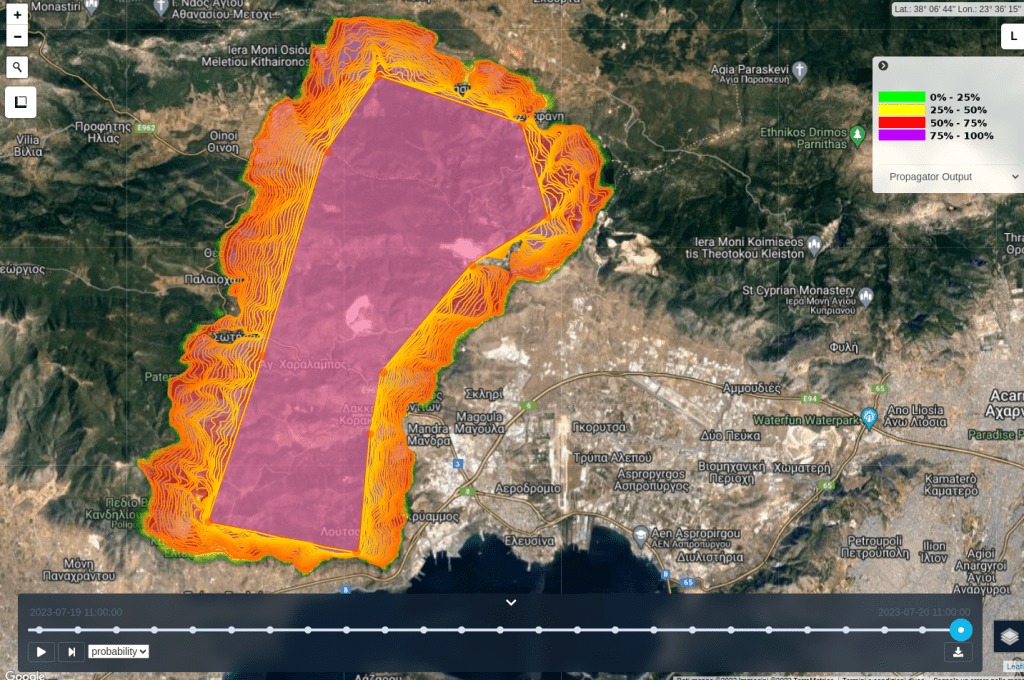As Greece grapples with an escalating wildfire emergency, it signals the start of a wildfire season that unfortunately marks the summer months not only in Mediterranean countries but also in countries as far as Canada.
The ARISTOTLE-eENHSP project (funded by DG-ECHO), draws upon the expertise of CIMA Research Foundation. CIMA supports the Emergency Response Coordination Centre (ERCC) by providing comprehensive risk assessment and monitoring of flood and forest fires. In particular, CIMA is currently the “chair” of the working group on forest fires, which also involves other project partners (AEMET, IPMA and METEO FRANCE). Beyond the routine task of monitoring and forecasting the potential risk of forest fires, the working group is always on standby by ERCC to offer specific information in emergency situations.
In a notable expansion of our scientific involvement this year, we now support ERCC’s latest preventive actions including the establishment of the Emergency Response Coordination Centre Wildfires Support Team. This team is dedicated for the monitoring and analysis of critical situations from mid-June to mid-September, and already proved its worth during the Canadian wildfires outbreak of 2023.

The Wildfires Support Team includes the participation of an on-site representative of the Forest Fire group from the ARISTOTLE project. In particular, the specialized staff from CIMA and IPMA are taking turns in Brussels to analyze the potentially critical situations and their evolution, supported by the collective expertise of the rest of the working group.
As part of their support to the ERCC during this period, ARISTOTLE-eENHSP experts work in both routine monitoring and emergency activation. The monitoring activities require the analysis of environmental conditions for the assessment of fire risk (e.g., state of the vegetation fuel, weather conditions, hazard indices…), the collection of information on fires in progress and the modeling/forecasting phase to identify areas needing short-term attention. Simultaneously, it includes the gathering and analysis of information sent by Member States concerning their availability in the event of an emergency. Many States, including Italy, have signed an agreement with the EU Civil Protection Mechanism in which they agree to provide support means (Canadair, helicopters, ground teams …) if required, as is the case in Greece. They provide information on the availability of these means and resources to ERCC daily to facilitate coordination and mobilization in case of emergency.
In the case of Greece, activation was requested on July 18. Numerous active fires were affecting the country, due to extreme dry weather conditions and strong winds, in different areas: Attica ( in proximity of Athens), the Peloponnese and the island of Rhodes. In particular, requests were made for 4 Canadair and numerous ground teams. Two of the Canadair were supplied by France, two by Italy; the ground teams were offered by Slovakia, Poland, Romania, Bulgaria, and Malta. The operations, coordinated by ERCC, were able to start as early as 19 July, one day after the request – all with the close coordination provided by the Wildfires Support Team.
In the event of an emergency activation, the Wildfires Support Team monitors the situation, following the progress of the various fire fronts and using different tools to predict their advance trajectory. The service primarily uses the European Forest Fire Information System and weather forecasts provided by the European Weather Centre ECMWF.
CIMA Research Foundation further enhances this information with specialized modeling tools such as PROPAGATOR and RISICO (both developed in-house). For example, the PROPAGATOR model probabilistically measures the spread of a fire. During the Greek activation, it allowed us to simulate the progress over the next 24 hours, given an already known front, highlighting the possible impacts on inhabited areas. Meanwhile, the RISICO system integrates into the danger rating, in addition to the hourly meteorological information. It also incorporates the main parameters that determine the behavior of the fire such as vegetation fuel and its moisture content, and the interaction between the wind and the morphology of the territory. This allows us to highlight the areas where the persistence of critical conditions increases the probability that a fire, after an ignition, could spread rapidly, and with severe flame intensity will make it difficult to control. It is in such cases that the support of the European mechanism can enhance the availability of resources, thereby reducing the intervention time and making fire suppression l more efficient.
In the cover picture: a scenario analysis with PROPAGATOR, the model developed by CIMA Research Foundation
